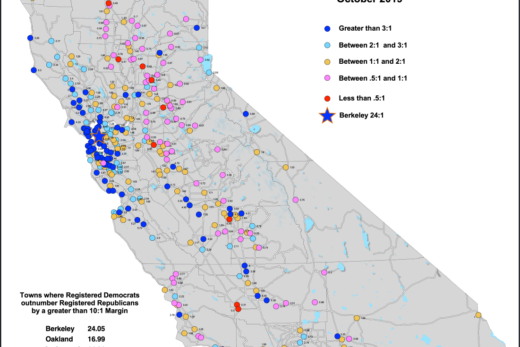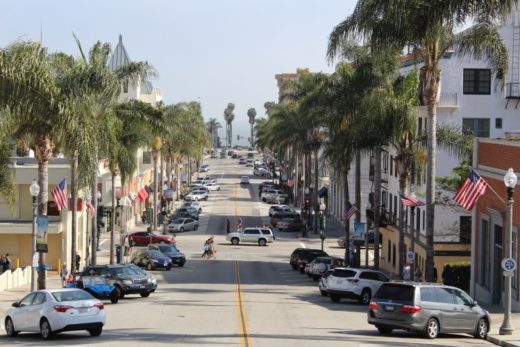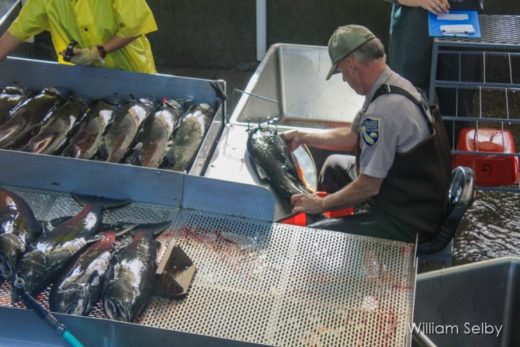It has become an unfortunate and disturbing annual Golden State dance during the last several years. Severe drought plagues the majority of the state, followed by extended record heat waves, followed by record catastrophic wildfires, followed by our analysis of the latest apocalypse on this web site. We now watch the unimaginable become reality: 2021 could be the worst water shortage and fire year yet. By August, most of the state was suffering under exceptional to extreme drought. Dwindling water supplies forced drastic cuts to farms, fisheries, and cities. Farmers protested on the national news while the fishing industry suffered crippling losses. Water bills skyrocketed while local sources dried up. The Golden State’s legendary water wars were on steroids again. And these water woes extended far beyond our borders and across the West as the first water shortage ever declared in the Colorado River Basin was forcing mandatory water cuts in nearby states. Dehydrated ecosystems parched by brutal heat waves were burning in conflagrations that included the largest single wildfire (the Dixie Fire had scorched more than 900,000 acres by September) and second-largest overall fire in California history. And we still must anticipate autumn’s dry, desiccating offshore winds that usually mark the peak of the fire season.
We add this September 1 update. The Caldor Fire made history by burning all the way across the west side of the Sierra Nevada Mountains and over the crest to the east side. (The larger Dixie Fire on the northern fringe of the Sierra Nevada may have been the first in recorded history to accomplish this, just weeks earlier.) As it expanded to more than 200,000 acres and raged toward Lake Tahoe Basin resorts, the Caldor Fire took center stage in media coverage. When about 21,000 people were evacuated, California’s beloved South Lake Tahoe became a ghost town. The following excerpt, from an August 31 New York Times article about megafires, summed up the latest western fires nightmare: “No matter how many people you have out on these fires, it’s not a large enough work force to put the fire out,” said Malcolm North, a fire expert with the U.S. Forest Service and a professor at the University of California, Davis. “You can save particular areas or particular homes,” Professor North said. “But the fire is pretty much going to do what it’s going to do until the weather shifts.”
When red flag conditions spread, all National Forests in California were closed while exhausted fire crews fought on into September, 2021. It is little surprise that inland weather stations were recording their warmest three combined summer months (June, July, and August) in history. That included the National Weather Service in nearby Reno, where average temperatures of 77.4 F (25.2 C), and average highs near 94 F (34.4 C), broke 2017’s hottest three summer months records. By mid-September, state fire statistics were daunting: more than 7,000 wildfires had burned more than 3,500 square miles (9,065 square kilometers). By then, temperatures were down, humidities were up, and red flag warnings disappeared across the state, allowing fire crews to contain the blazes, while most national forests reopened. Anxious Californians were left to anticipate autumn’s offshore wind events that might rekindle another wildfire year already gone mad.

We have dedicated an enormous amount of time and space on this web site to these reoccurring calamities during the last several years. You might consult our publication for more detailed scientific explanations. Our weather, climate change, and wildfire stories on this web site have included abundant research and analyses with a wide range of perspectives. You can click back to them for a better understanding of how we got here and where we might be headed. In this story, we briefly focus on the latest round of catastrophic wildfires in northern California (as of August), the weather patterns that incited them, and the impacts they are having far beyond the Golden State.
(Where you see numbers blocked in parentheses in this text, you might consult Page 2 of this story for some more detailed definitions and explanations.)

Source: NOAA and San Francisco State University.

Shasta Feels the Burn
Mt. Shasta, 2021, serves as just one example of how extreme weather patterns are reshaping landscapes around the state. By July, snow packs that usually cover and help insulate Shasta’s glaciers had disappeared, leaving the icy masses vulnerable to accelerated melting during this latest historic summer of heat and drought. Ash and soot, falling out of smoke from the region’s epic fires, darkened surfaces, cut albedo, and hastened the melting. By late summer, meltwater carrying mud and debris flows was spasmodically cascading down the volcano. Roads, bridges, and other infrastructure were especially threatened by debris flows along Mud Creek and around the town of McCloud from sudden outbursts off of Konwakiton Glacier. As the media searched for some explanations from the experts, this quote from the L.A. Times, published on September 8, 2021, was repeated in various forms within local and national news stories: “It’s scary. The pace of change right now on Mt. Shasta seems very fast, and its glaciers are getting smaller at a rate that makes me sad,” said Andy Calvert, scientist in charge at Mt. Shasta for the U.S. Geological Survey. “The principal problem now is mudflows,” he said. “They are sudden releases of water that scour out stream channels and pick up rocks and dirt on the way down, leaving a muddy mess.”
According to scientists studying these changes, such as glaciologist Mauri Pelto, Mt. Shasta has lost at least 50% of its glacial ice volume in the last 20 years. More glacial ice was lost on Shasta in this summer of 2021 than in any other year in recorded history. The few remaining glaciers nestled against California’s other high country peaks have been retreating at similar rates.

Setting the Stage for Fire
We start with another exceptionally dry 2020-2021 rainy season throughout most of the state. Stubborn high pressure vacillated over us or just to our west, repeatedly forcing winter storms to our north, up over the resilient ridge, and then back down to our east. With some exceptions, much of the rainy season was dominated by relatively dry “inside sliders” that dropped into Nevada, lacking substantial sources of moisture, but circulating high winds. (1) Parts of central and southern California were left with less than half of their annual average rainfall and some weather stations were closer to 1/3 of average. Then, early summer started with a bang in the form of massive high pressure systems that produced record heat domes. This included the historic heat wave that broke all-time records from the Canadian Border, through Washington and Oregon, down into California’s inland regions. Heavy, dense air sinking out of the strongest high pressure was compressed all the way to the surface, creating adiabatically-heated ovens. Record high temperatures were recorded across our deserts, inland valleys, and up to our mountaintops. After a punishing June and July, mid-August high temperatures in the northern Sacramento Valley and other northern inland valleys soared well over 100 F, even with veils of smoke shielding the most intense sunlight.

Relief near the Beach
The only “good” news we have about these summer heat waves is that, at least into August, temperatures along the immediate coast frequently remained relatively mild and even below average in the fog belt that stretched along many beaches all the way down to the Mexican Border. These shallow, fresh sea breezes stood in contrast to the plumes of thick smoke circulating farther inland. We explore this cold coast oddity in another adjacent story within this three-part weather series on our web site. Check it out.

Fires Behaving Badly
As expected, the prolonged drought and searing inland heat waves led to another summer of “we’ve never seen wildfires behave like this.” The first one to be called the biggest was the rather odd Lava Fire that was sparked by lightning on June 24 and burned into August. Firefighters had already noted conditions in June that more resembled August as the fire burned around and up the slopes of Mt. Shasta, northeast of Weed. The fires burned all the way up to the tree line on steep, inaccessible, craggy lava terrain with limited water sources. As more threatening fires erupted throughout the surrounding region that includes northern Californian, the Sierra Nevada, and Oregon, adding to the thick smoke clouds, attention turned away from this slow-moving Lava Fire.

Larger Fires, Spreading Smoke Clouds
Among the growing conflagrations, the Dixie Fire exploded to a single record 600,000+ acres by mid-August, creating its own weather systems. Choking smoke plumes had mushroomed, spread across northern California, and then merged and traveled farther north into inland areas of Oregon and Washington. For weeks, prevailing winds spread the smoke from California and Oregon fires north and then east, across Nevada, Utah, Idaho, Montana, Wyoming, and Colorado. Persistent high pressure capped the smoke, causing poor air quality and blocking views throughout and beyond those states, spreading the red veil of gloom over an area larger than anyone could remember. (2) Big Sky Country had turned to big smoke country in the hot, dry air under relentless high pressure. Visitors and locals in and around National Parks (such as Grand Teton, Yellowstone, and Glacier) made famous for their blue sky views and definitive cloud formations, coughed their way through the smoky haze. Denver and Salt Lake City recorded some of the worst air quality in the world. By mid-July, noticeable smoke clouds had already arrived on the East Coast, in a repeat performance reminiscent of last year’s firestorm stories. The ominous summer of 2021 wore on as firefighters and just about everyone else began to dread the next building high pressure system and summer heat wave, while shifting prevailing winds determined who would suffer most from dangerous smoke. We were all connected again by the local and global changes that are impacting all of us.

It Doesn’t Stop Here.
We wish the story could stop here. By August, the Dixie Fire alone had destroyed more than 1,000 structures and the entire town of Greenville. Its smoke plume formed a thick line of condensation all the way across Nevada. (3) But there may be more ominous warning signs on the immediate horizon.

Looking for Miracles in all the Wrong Places?
Without some sort of anomalous – or perhaps miraculous – weather pattern shift, California will experience another punishing autumn that will go down in the record books. All you have to do is observe the parched slopes and alarmingly desiccated plant communities in southern and central California…illustrating the cumulative effects of successive droughts and record heat years. Cooler temperatures with exceptional and substantial early season rains must arrive before autumn’s dry offshore Diablo and Santa Ana winds erupt to whip up the peak fire season. The annual race to see what comes first has never been more consequential. And should the next wet season end with more improbable drought, many of our reservoirs and other sources of water will dry up. Is this sounding too familiar in this state where the unprecedented has become the normal?
Follow the latest California drought on this web site: https://droughtmonitor.unl.edu/CurrentMap/StateDroughtMonitor.aspx?CA
Jing Liu Connects Dots Leading to the Pika
We continue to recognize how accelerating climate change and these epic fires are impacting and even threatening such a wide range of plant and animal species. Jing Liu has written a story about what some people might consider to be one of the most adorable: the American Pika. You won’t be disappointed if you take a little time to learn some animal science from Jing’s enthralling story, exceptional maps, and attached videos. This little pika lives around the very habitats that have been incinerated this summer and featured on our web site. Here is the story: https://storymaps.arcgis.com/stories/5d70673f2ab641b389dcd15e4779bdb7



















